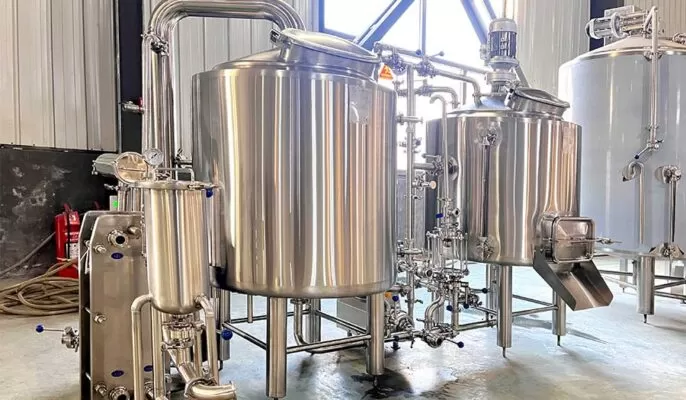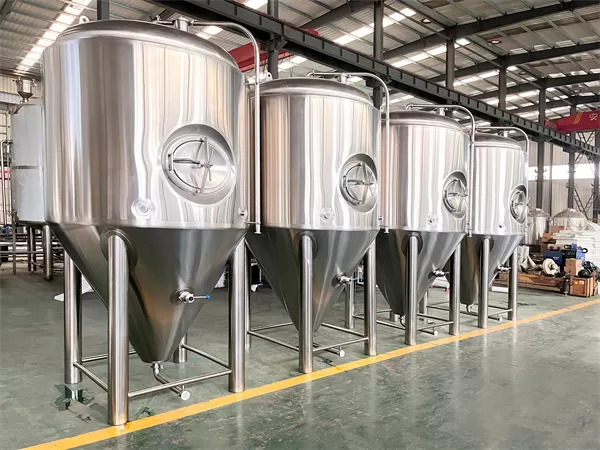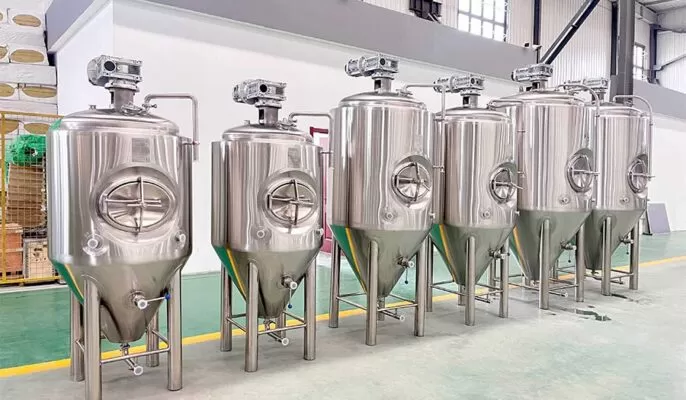Brewing beer is an art that has been perfected over centuries, and with the advent of modern technology, the process has become more streamlined and efficient. Enter the automatic brewing machine, a game-changer in the world of homebrewing and small-scale commercial brewing. This remarkable piece of equipment takes the guesswork out of the brewing process, allowing brewers to produce consistently high-quality beer with minimal effort.
Overview of Automatic Brewing Machines
An automatic brewing machine is a self-contained unit that automates the entire brewing process, from mashing and lautering to boiling and cooling the wort. It typically consists of several interconnected vessels, heating and cooling elements, pumps, and a control system that regulates the various stages of the brewing process. The machine takes care of temperature control, timing, and a host of other critical factors, ensuring that each batch of beer is brewed to perfection.
Understanding the Brewing Process
Brewing is the process of creating beer by converting sugars derived from cereal grains into alcohol through fermentation. The brewing process can be divided into four main stages: malting, mashing, boiling, and fermenting.
The Brewing Process
| Stage | Description |
|---|---|
| Malting | The process of converting barley grains into malt. |
| Mashing | The process of converting the starches in malt into sugars. |
| Boiling | The process of sterilizing the wort and extracting flavors from the hops. |
| Fermenting | The process of converting the sugars in wort into alcohol. |
Malting
The malting process begins with the steeping of barley grains in water. The grains are then allowed to germinate, which converts the starches in the grains into sugars. The germination process is stopped by kilning, or drying, the grains.
Mashing
The malted grains are then crushed and mixed with hot water in a mash tun. This process converts the remaining starches in the grains into sugars. The resulting liquid, called wort, is then drained off and boiled.
Boiling
The wort is boiled in a kettle for about an hour. This process sterilizes the wort and extracts flavors from the hops that are added to the kettle.
Fermenting
The wort is then cooled and transferred to a fermentation vessel. Yeast is added to the wort, which converts the sugars into alcohol. The fermentation process takes about two weeks.

Types of Automatic Brewing Machines
| Type | Description | Pros | Cons |
|---|---|---|---|
| Drip Coffee Maker | Uses a filter to drip hot water over ground coffee beans. | Easy to use, affordable, makes a large pot of coffee. | Coffee can be weak or bitter if not brewed correctly. |
| Pod Coffee Maker | Uses pre-filled pods of coffee grounds to brew a single cup of coffee. | Quick and convenient, makes a consistent cup of coffee. | Pods can be expensive and wasteful. |
| Espresso Machine | Forces hot water through finely-ground coffee beans to make a concentrated cup of coffee. | Makes a strong, flavorful cup of coffee. | Can be expensive and difficult to use. |
| French Press | Steeps ground coffee beans in hot water for a period of time, and then presses down on the plunger to separate the coffee grounds from the brewed coffee. | Makes a rich, flavorful cup of coffee. | Can be messy and time-consuming to use. |
| Cold Brew Coffee Maker | Brews coffee with cold water over a period of several hours. | Makes a smooth, less acidic cup of coffee. | Can be time-consuming to brew. |
In addition to the types of automatic brewing machines listed above, there are a number of other types of automatic brewing machines on the market, including:
- Keurig machines: Keurig machines are a type of single-serve coffee maker that uses K-Cups, which are pre-filled pods of coffee grounds.
- Tassimo machines: Tassimo machines are a type of single-serve coffee maker that uses T-Discs, which are pre-filled pods of coffee grounds, tea, or hot chocolate.
- Nespresso machines: Nespresso machines are a type of espresso machine that uses Nespresso capsules, which are pre-filled pods of coffee grounds.
Brewing with an Automatic Machine
Brewing with an automatic machine is a streamlined process, but it still requires some knowledge and attention to detail. Here’s a general overview of the steps involved:
1. Preparing the Ingredients Before starting the brewing process, you’ll need to gather and measure all the necessary ingredients, including malted grains (for all-grain or partial mash systems), malt extract (for extract systems), hops, yeast, and any additional adjuncts or flavorings.
2. Setting up the Machine Next, you’ll need to set up the automatic brewing machine according to the manufacturer’s instructions. This may involve loading the grains into the mill and mash tun, connecting the various vessels and tubing, and programming the control system with the desired brewing parameters.
3. Initiating the Brewing Process Once everything is set up, you can initiate the brewing process. The machine will take care of the mashing, lautering, boiling, and cooling steps automatically, following the programmed parameters.
4. Adding Hops and Other Ingredients At specific points during the boiling process, you may need to manually add hops or other ingredients, as instructed by the recipe or the machine’s control system.
5. Cooling and Pitching Yeast After the wort has been boiled and cooled, the machine will transfer it to the fermentation vessel. At this stage, you’ll need to pitch the yeast manually, following the recommended procedures.
6. Fermentation and Conditioning The fermentation and conditioning processes typically occur outside of the automatic brewing machine, but some advanced models may offer features to monitor and control these stages as well.
7. Packaging and Serving Once the beer has been conditioned, it’s ready for packaging and serving. Depending on your setup, you may need to transfer the beer to bottles, kegs, or cans manually.
Capacity, Spaces, and Design Considerations
| Aspect | Description |
|---|---|
| Capacity | Automatic brewing machines are available in various batch sizes, ranging from small 2.5-gallon (9.5-liter) systems for homebrewers to large-scale 15-barrel (1,800-liter) systems for commercial operations. Consider your expected output and storage space when selecting a machine’s capacity. |
| Spaces | These machines require dedicated spaces with appropriate ventilation, drainage, and access to water and electricity. Ensure you have enough room for the machine itself, as well as any additional equipment or storage requirements. |
| Design | Automatic brewing machines come in various designs, from compact all-in-one units to modular systems with separate vessels for each brewing stage. Consider factors like ease of use, maintenance, and cleaning when evaluating different designs. |
Customization and Automation
One of the significant advantages of automatic brewing machines is their ability to be customized and automated. Many models offer advanced control systems that allow you to program and adjust various parameters, such as temperature profiles, timing, and ingredient additions. Some even offer remote monitoring and control capabilities through smartphone apps or web interfaces.
Additionally, some machines can be integrated with automated systems for tasks like grain milling, hop additions, and even fermentation monitoring and control. These automated features can significantly streamline the brewing process and ensure consistent results batch after batch.
Automatic Brewing Machine Suppliers and Price Range
| Supplier | Price Range (USD) | Notable Products |
|---|---|---|
| Ss Brewtech | $2,500 – $15,000 | Brewmaster Series, Chronical Series |
| Grainfather | $800 – $2,000 | Grainfather G30, Grainfather G70 |
| Braumeister | $2,000 – $4,000 | Braumeister 10L, Braumeister 20L |
| Clawhammer Supply | $3,000 – $10,000 | Psyonic Series, BrewSculptor Series |
| Brewha | $2,500 – $6,000 | BIAC, BIAC Xtended |
Please note that prices can vary based on factors such as machine capacity, features, and customization options. Additionally, shipping and installation costs may apply.
Installation, Operation, and Maintenance
| Aspect | Description |
|---|---|
| Installation | Most automatic brewing machines require professional installation, which may involve plumbing, electrical, and ventilation work. Some suppliers offer installation services, or you can hire a local contractor. Ensure proper ventilation, drainage, and access to utilities. |
| Operation | Operating an automatic brewing machine requires some training and familiarity with the control system and brewing processes. Manufacturers typically provide detailed manuals and may offer training programs or online resources. |
| Maintenance | Regular maintenance is crucial for ensuring the longevity and performance of your automatic brewing machine. This may include cleaning, descaling, replacing gaskets and seals, and periodic service by a qualified technician. |
Choosing the Right Supplier
When selecting a supplier for your automatic brewing machine, consider the following factors:
| Factor | Description |
|---|---|
| Reputation and Experience | Look for suppliers with a proven track record in the brewing industry and positive customer reviews. Experienced suppliers can provide valuable guidance and support. |
| Product Quality and Reliability | Invest in high-quality machines from reputable manufacturers known for their durability and consistent performance. Consider factors like construction materials, components, and quality control processes. |
| Service and Support | Evaluate the level of service and support offered by the supplier, including installation assistance, training, and ongoing maintenance and repair services. |
| Customization Options | If you require specific customizations or integrations, ensure the supplier can accommodate your needs and provide tailored solutions. |
| Warranty and Guarantees | Review the warranty and guarantee terms offered by the supplier to protect your investment and ensure peace of mind. |
Pros and Cons of Automatic Brewing Machines
| Pros | Cons |
|---|---|
| Convenience: Automatic brewing machines make it easy to brew a cup of coffee or tea with the touch of a button. | Cost: Automatic brewing machines can be expensive, especially high-end models with a lot of features. |
| Consistency: Automatic brewing machines produce consistent results, cup after cup. | Complexity: Some automatic brewing machines can be complex to use and clean. |
| Variety: Many automatic brewing machines offer a variety of features and settings, allowing you to customize your brew. | Space: Automatic brewing machines can take up a lot of counter space. |
| Time-saving: Automatic brewing machines can save you time, especially if you brew coffee or tea frequently. | Taste: Some people prefer the taste of coffee or tea brewed manually. |
| Energy efficiency: Many automatic brewing machines are energy efficient, using less power than traditional stovetop or microwave methods. | Environmental impact: Automatic brewing machines can produce a lot of waste, such as coffee grounds and disposable cups. |
FAQs
Q: Can I brew all styles of beer with an automatic brewing machine? A: Yes, most automatic brewing machines are versatile enough to brew a wide range of beer styles, from light lagers to robust stouts and everything in between. However, some specialty or experimental styles may require additional equipment or manual interventions.
Q: How much beer can an automatic brewing machine produce? A: The batch size or capacity of automatic brewing machines varies widely, ranging from small 2.5-gallon (9.5-liter) systems for homebrewers to large-scale 15-barrel (1,800-liter) systems for commercial operations. Consider your expected output and storage space when selecting a machine’s capacity.
Q: Can I customize or modify an automatic brewing machine? A: Many automatic brewing machines offer customization options, such as adjustable temperature profiles, timing, and ingredient additions. Some models can also be integrated with automated systems for tasks like grain milling, hop additions, and fermentation monitoring and control. However, significant modifications may void the manufacturer’s warranty or compromise the machine’s performance.
Q: How difficult is it to clean and maintain an automatic brewing machine? A: Cleaning and maintenance requirements vary depending on the machine’s design and features. Most automatic brewing machines require regular cleaning and descaling to ensure optimal performance and longevity. Some models are designed with features that facilitate easier cleaning and maintenance, such as removable components or integrated cleaning cycles.
Q: Can I use an automatic brewing machine for small-batch or experimental brewing? A: While automatic brewing machines are often associated with larger-scale brewing operations, many models are suitable for small-batch or experimental brewing. Some suppliers offer compact, homebrewer-friendly systems that allow for recipe experimentation and customization.





